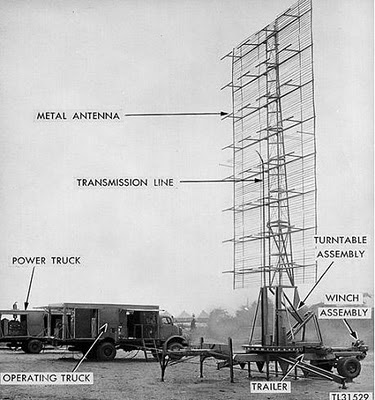The SCR-270 was the US Army's primary long-range radar throughout World War II. Also known as the Pearl Harbor Radar, the "SCR-270" stood for "Signal Corps Radio model 270". On December 7, 1941, it detected the incoming raid about half an hour before the attack on Pearl Harbor began. Two variants of this radar were developed, the mobile SCR-270, and the fixed SCR-271 which used the same electronics but used an antenna with somewhat greater resolution. An upgraded version, the SCR-289, was also produced, but saw little use. All of the -270 versions were later replaced by newer microwave units after the cavity magnetron was introduced to the US during the Tizard Mission. The only early warning system of the sort to see action was the AN/CPS-1, which was available in late 1944.
The original SCR-270 was composed of a four-truck package. The antenna was mounted on a folding mount derived from a well-drilling derrick, and could be mounted on a flatbed trailer for movement. When opened it was 55 feet (17 m) tall, mounted on an 8-foot (2.4 m) wide base containing motors for rotating the antenna. The antenna itself consisted of a series of 36 half wave dipoles backed with reflectors, arranged in three bays, each bay with twelve dipoles arranged in a three-high four-wide stack. (Later production versions of the SCR-270 used 32 dipoles and reflectors, either eight wide by four high (fixed) or four wide by eight high (mobile)). The antenna mount required another truck (although it had its own wheels and didn't need a trailer), the generator and broadcast amplifier were in another truck, and the operations van was the last.
The antenna of the SCR-270 was swung by command from the operations van, the angle being read by reading numbers painted on the antenna mount. The radar operated at 106 MHz, using a pulse width from 10 to 25 microseconds, and a pulse repetition frequency of 621 Hz. With a wavelength of about nine feet, the SRC-270 was comparable to the contemporary Chain Home system being developed in England, but not to the more advanced microwave systems in Germany. This frequency did turn out to be useful, as it is roughly the size of an airplane's propeller, and provided strong returns from them depending on the angle. Generally it had an operational range of about 150 miles (240 km), and consistently picked up aircraft at that range.

No comments:
Post a Comment